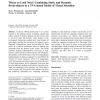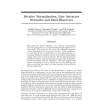95 search results - page 19 / 19 » Determination of Motion Breakpoints in a Task Sequence from ... |
NECO
2010
13 years 4 months ago
2010
To allow the hidden units of a restricted Boltzmann machine to model the transformation between two successive images, Memisevic and Hinton (2007) introduced three-way multiplicat...
PAMI
2007
13 years 5 months ago
2007
—An open vision problem is to automatically track the articulations of people from a video sequence. This problem is difficult because one needs to determine both the number of p...
SASO
2007
IEEE
14 years 16 days ago
2007
IEEE
— Designing and implementing artificial self-organizing systems is a challenging task since they typically behave nonintuitive and no theoretical foundations exist. Predicting a...
COGCOM
2010
13 years 3 months ago
2010
To decide ``Where to look next ?'' is a central function of the attention system of humans, animals and robots. Control of attention depends on three factors, that is, lo...
NIPS
1998
13 years 7 months ago
1998
Gain control by divisive inhibition, a.k.a. divisive normalization, has been proposed to be a general mechanism throughout the visual cortex. We explore in this study the statisti...


